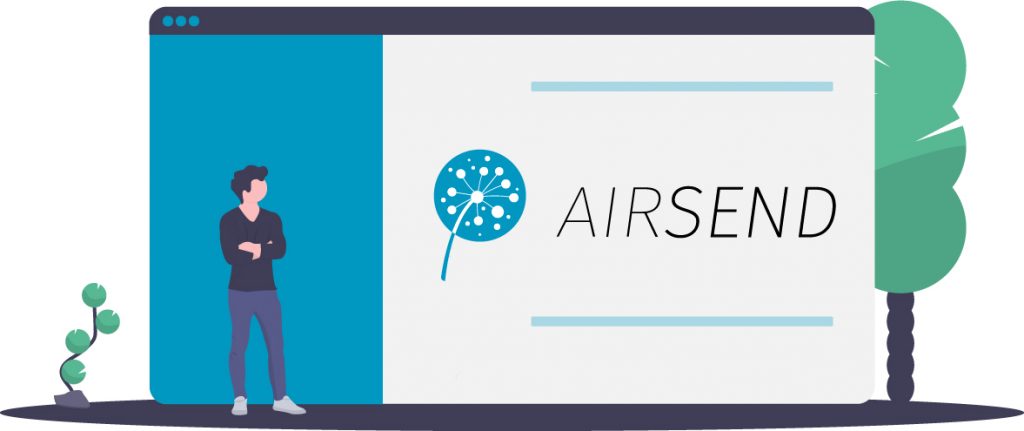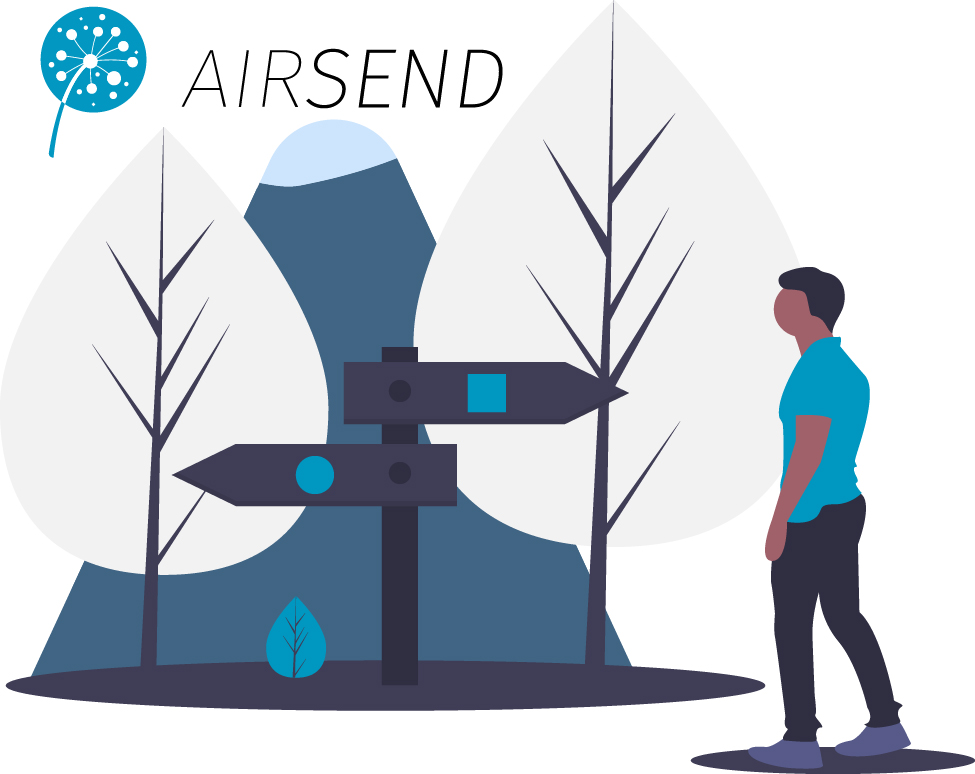
Running a business has been described as “insomniatic,” “constant,” and “challenging.” It’s not for everyone, but for those who choose entrepreneurship, the process and result of creating a new brand and launching a product or service can be highly rewarding. The excitement and sense of accomplishment that come from solving a problem and sharing your solution with the world far outweigh the stress of never-ending coffee breaks and sleepless nights.
AirSend began as a desire to make something new that would help take us to the next level of success as a company with prior experience in file storage and sharing.
As with many bootstrapped start-up product launches, the story of AirSend is one of camaraderie, vision, and leadership. We went from product concept to MVP launch in four months and created a digital workspace for professionals and creatives that has already begun to garner high praise from users.
We wanted to share our story because we think it could be helpful to other entrepreneurs.
These are the lessons we learned through the process of creating the AirSend brand story to launch our MVP.
Lesson #1: Every good solution begins with a worthy problem.
The best products and services make your customers’ lives easier, and the way to do that is to solve a problem.
So how do you find a worthy problem?
We used three criteria to find our problem space.
- The problem needed to be personal — something the team could relate to with ease.
- The problem needed to be an issue faced by large numbers of people on a daily basis (thus generating the possibility of millions to billions of future customers).
- The problem needed to have a solution that we could provide which would have a transformative impact on customers’ lives by saving them time and money or improving their quality of life.
After extensive team brainstorming using our criteria as a framework, the problem we zeroed in on is context switching at work.
What is context switching?

Context switching refers to the act of jumping, or switching, between different tasks and apps. It requires significant mental energy and has been called a killer of productivity.
As a team, we experienced the negative impact of context switching on a daily basis when we created our first product — FileCloud, an enterprise file sharing platform that is currently used by millions of users in 3000+ organizations across 90+ countries. Working as a bootstrapped start-up meant that everyone was constantly juggling multiple tasks and apps to get work done. We also saw the negative impact of context switching on FileCloud customers since the product gave us an inside view on how people do work and share files.
Context switching was a problem that we could deeply relate to; it is a problem that is faced by almost everyone; and because of its large negative impact on productivity, creating a solution to this problem — which we did with AirSend — would have a transformative impact on customers’ lives.
Lesson #2: Have a clear vision so you know where you are going.

Once we had our problem, we needed to form a clear picture of our destination. We needed to give voice to our vision.
Vision is all about the future. It’s the North Star that guides you over mountains, across rivers and oceans, through seemingly insurmountable challenges.
When forming your vision, make sure it, like the North Star, is lofty and inspiring. A vision is what keeps the team going through those sleepless nights. It is fuel for passion and a guiding light that ensures everyone continues to work towards the same goal.
Our vision for AirSend is: Connecting People to Get Work Done.
We want to help people increase productivity — get work done better and faster. And we want to do that by making it easier to connect and collaborate by addressing the issue of context switching.
Research says context switching can cost up to 40% of your time (one to three hours of an eight-hour work day).
Imagine if AirSend helped reclaim just 15 minutes of productivity per day for 10 million people (just 0.14% of the world’s population). That would be 625 million productive hours per year, or $10.6 billion of additional productivity based on a median hourly wage of $17.00 per hour.
Even a small improvement to productivity can bring transformative benefits to society. If we can accomplish the above, then we will have achieved our vision.
Lesson #3: Choose the path you’re taking to get to where you want to go.

After homing in on our North Star, we needed to clearly define the road we were going to take to get there. This is where mission comes in.
While vision is all about the future, mission is about what you are doing right now and who you are serving to reach your vision. Mission is the strategy, the actions that you need to take on a consistent basis, to accomplish your vision.
While context switching affects all professionals, it is worst for freelancers, creatives, lawyers, accountants, and other professionals who work with clients. These professionals not only need to handle work context, they also deal with client context on a daily basis.
We decided to make AirSend about solving the problem of context switching for these professionals, so our mission became to build a people-centric digital workspace that is easy to use, fast, and functional so that professionals and their clients can get work done.
Lesson #4: Decide on your mode of transportation.
Once we had a clearly defined path, it was time to decide how we were going to travel that path — we needed to develop our guiding principles.
Guiding principles are an extension of your mission statement. They tell you how to execute your mission and give your team a solid vehicle to get where you want to go.
We believe that for a digital product to become beloved and iconic, it has to be blazing fast, immensely appealing, and of high value to its users. With these factors in mind, we decided on the following guiding principles to fulfill AirSend’s vision and mission:

- Easy, Fast and Functional — Our product needs to be easy to use, fast, and functional at all times.
- Exceptional Utility and Value Pricing — We will offer exceptional utility at a compelling price point to make our product accessible to as many people as possible.
- Perfection with Purpose — We will work with purpose towards perfection in everything we do, from design to development and beyond. Perfection may be impossible, but we will never give up. That is perfection with purpose.
Lesson #5: Know who you are.

At the end of the day, who are you? In other words, what are your core values? Knowing the answer to that question has a huge impact on everything that you and your team accomplish.
Clearly defining your core values is essential. It is the final piece of the picture. Your problem is your reason to start the journey, your vision is your North Star, your mission is your path, your guiding principles are your vehicle, and your core values are you.
Without Odysseus there would be no Odyssey. Similarly, a team without core values isn’t a team.
Our values are that we are customer-centric and authentic. That means we strive to solve the difficult real-world problems that matter most to our customers, and we stay true to ourselves by adhering to that purpose.
Summary
Here is a summary of what we came up with after going through the above brand creation process.
Our Vision
Connecting People to Get Work Done.
We envision a world where professionals and clients connect and collaborate quickly and easily to get work done.
Our Mission
Our mission is to transform the way professionals work with clients by providing a people-centric digital workspace that is easy to use, fast, and functional.
Our Guiding Principles
- Easy, Fast, and Functional — We ensure that AirSend is easy to use, fast, and functional.
- Exceptional Utility and Value Pricing — We strive to offer exceptional utility at a compelling price point to make our product accessible to as many people as possible.
- Perfection with Purpose — We work with purpose towards perfection in everything we do, from design to development and beyond. Perfection may be impossible, but we will never give up. That is perfection with purpose.
To see the complete AirSend branding guide, click here.
The journey continues.
Based on our vision, mission, guiding principles, and core values, we built a contextual workspace that brings all your conversations, files, and to-do lists into one place so that you can get work done better and faster. This workspace will save millions of hours for professionals who work with clients, improve their focus and quality of life, and help them get work done faster and more easily. But the AirSend journey is far from over. In fact, it has just begun.
One of the key pillars that has helped us create and launch a product successfully has been the work we put in to defining who we are and what we want to do as a team. Everything else — the meticulous work that goes into design, development, marketing — is driven and guided by the factors discussed in the lessons we’ve learned so far.
We hope that sharing our story helps you on your own journey of entrepreneurship.
Bon voyage! — The AirSend Team























